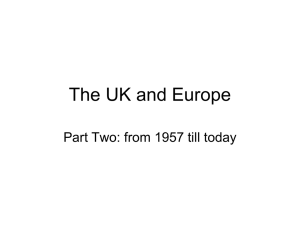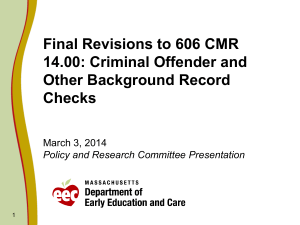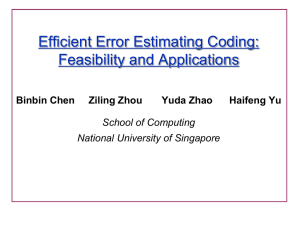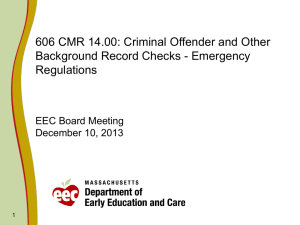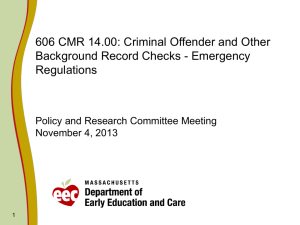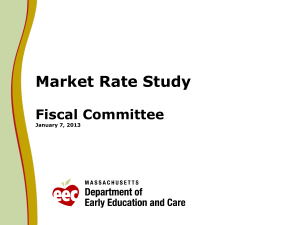EEC Internal Control Plan
advertisement
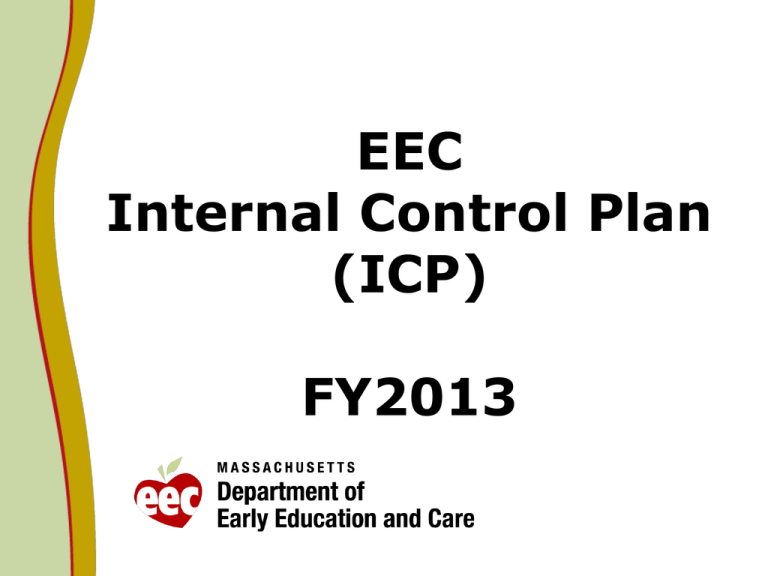
EEC Internal Control Plan (ICP) FY2013 Direction from Secretary Malone Acting EEC Commissioner Thomas Weber shall initiate a top-to-bottom review of EEC’s Internal Control Plan as soon as practicable. He should seek the advice and guidance of the state Comptroller’s Office in that review. He should evaluate and implement any recommendations that result from that review. 2 Internal Control Plan 3 Initiate a top-to-bottom review of EEC’s internal control plan immediately Seek advice and guidance from the State Comptroller’s Office in that review. Evaluate and implement any recommendations that result from that review. EEC Internal Control Plan Objectives An ongoing process in which an organization provides and strives to provide reasonable assurance it will achieve its goals. Encompasses all the measures and practices that are used to counteract exposures to risks. 2007 CTR Internal Control Guide (pg. 6, 10) 4 Key Principles of an Internal Control Plan Operations are effective and efficient. Financial reporting is reliable. The ICP is in compliance with all applicable laws and regulations. Satisfactory standards are met. Resources are used efficiently and economically. All objectives are successfully achieved. 2007 CTR Internal Control Guide (pg. 30) 5 Internal Control Facts Internal Controls start with a strong control environment. Emphasis on tone is set at the top. An internal control plan is the responsibility of Senior Leadership with a commitment from entire agency. Integral to every aspect of EEC’s operating functions, not just finance. Helps minimize risks through policies and procedures. 2007 CTR Internal Control Guide (pg. 6-7) 6 Compliance Requirements and Responsibilities Federal OMB Circulars A-133, A-87, A-110, and A-123 Statement on Auditing Standards (SAS No. 112) Government Auditing Standards (Yellow Book) Committee of Sponsoring Organizations of the Treadway Commission (COSO) 7 Sarbanes-Oxley (SOX) 2007 CTR Internal Control Guide (pg. 25-30) State Chapter 647 of the Acts of 1989 Audit Committee (extension of a governing body) Internal Audit 5 Key Components of Internal Control System Control Environment First line of defense to mitigate risks. Builds a control consciousness within the control environment. Risk Assessment Impact to business objectives. Control Activities Actions, supported by policies and procedures that when carried out properly and timely, manage or reduce risk. Information and Communication Identify, capture, and communicate pertinent information that enables all to carry out their responsibilities. Monitoring Confirms all components are in place, properly designed and functioning effectively. 8 2007 CTR Internal Control Guide (pg. 26) EEC: FY2013 ICP Key Areas of Focus 9 Review FY12 plan to ensure compliance with CTR Internal Control Guide and Chapter 647 of the Acts of 1989. Respond to the findings in the FY2011 Single State Audit. Include new Control Activities and correlating Unit goals. Field Operations (i.e. Licensing inspections) Human Resources related transactions ( i.e. Travel Reimbursements) EEC: FY2013 ICP Key Areas of Focus (Cont’d) 10 Institute Business Continuity/Emergency Plan Ensure EEC’s operating functions continue during an unpredicted event. Clear delineation of Segregation of Duties Framework for processing transactions, report submission, and signature authority Update library of policies and procedures manuals referenced in ICP. Utilize EEC’s Internal Audit Software to conduct Risk Assessment process and reporting. EEC: FY2013 Internal Control Plan Process 11 1. Review of 2009 and 2012 plan with CTR Quality Assurance Bureau. 2. Email notice from Commissioner to staff indicating the ICP Process and importance of participation. 3. Review or development of Policies and Procedures by all EEC Unit Directors. 4. Conduct Internal Audits and Risk Assessments on all EEC control activities. 5. Disseminate Internal Control Plan to Unit Directors for review and revision. EEC: FY13 EEC Internal Control Plan Process (Cont’d) 12 6. Assemble all sections of the plan for first draft review. 7. Submission of first draft to CFO for review. 8. Produce final draft for Commissioner review. 9. Complete Internal Control Questionnaire as directed by CTR. 10. Distribute Fraud, Waste, and Abuse Statements to be signed by all EEC staff. EEC: FY2014 Internal Control Plan Process Project Timeline 13 DATE ACTIVITY 4/8/2013 Meet with CTR to review 2009 and 2012 EEC ICP. 4/15/2013 Notice to EEC staff from Commissioner on ICP Process and timelines. 5/15/2013 Review or development of Policies and Procedures by all EEC Unit Directors. 5/31/2013 Completion of Risk Assessments and Internal Audits by Audit Unit. 6/3/2013 Dissemination of ICP to Unit Directors for review and revision. Due to Audit Unit by June 14. 6/21/2013 Assemble all section for first draft review. 6/28/2013 Completion of Final ICP for CFO review. “Date” is the last date by which the activity should be completed. EEC: FY2014 Internal Control Plan Process Project Timeline (Cont’d) 14 DATE ACTIVITY 7/5/2013 Submission of final draft to Commissioner for review. 7/8/2013 Dissemination of Fraud, Waste, and Abuse Statement by all EEC Staff with 7/31/2013 due date. 7/12/2013 Complete Internal Control Questionnaire as directed by CTR. 15

